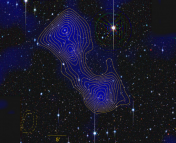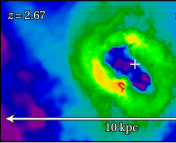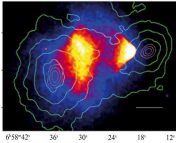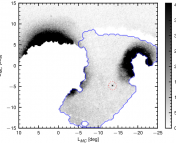- Paper title: Intergalactic Gas in Groups of Galaxies: Implications for Dwarf Spheroidal Formation and the Missing Baryons Problem
- Authors: E. Freeland, E. Wilcots
- First author’s affiliation: George P. and Cynthia W. Mitchell Institute for Fundamental Physics and Astronomy, Dept. of Physics and Astronomy, Texas A&M University, College Station, TX 77843
Introduction
While galaxies may be isolated, they are preferentially found in high density environments, called galaxy groups and galaxy clusters. This is a product of hierarchical formation, in which, over the course of cosmic history, ever larger dark matter halos became gravitationally collapsed and luminous structures merge to form new structures. Galaxy groups can have anywhere from a couple to ~ 102 galaxies; clusters, meanwhile, can have hundreds or even thousands of galaxies. But while these groups and clusters are rich in galaxies, they also contain diffuse, heated gas — the intracluster medium (ICM) and the intergalactic medium (IGM). X-ray observations of clusters clearly reveal this hot ICM, and a “warm-hot intergalactic medium” (WHIM), which had been predicted in simulations, has also been detected in groups. However, the spatial density distribution of this gas remains undetermined, and given that it comprises a significant fraction of the baryonic content in these groups, further study of the gas is important to constrain the possible dynamical effects it has on the constituent galaxies.
In the following paper, Freeland & Wilcots (2011) present observations of seven “double bent” radio galaxies (including two from a previous study that are reanalyzed) that do not have any X-ray detections of the IGM. Dense environments, such as groups and clusters, can bend the radio jets from galaxies. In turn, these bent jets can be used to constrain IGM enivronmental properties.
Observations and Methods
The radio observations were completed using the Very Large Array (VLA), principally from the FIRST survey. Optical spectroscopy was done using HYDRA on the WIYN 3.5m telescope, and redshifts were obtained from the Sloan Digital Sky Survey (SDSS).
The authors use the following Euler equation to describe the pressure balance inside and outside the non-relativistic jet.
Here, h is the width of the jet, R is the radius of curvature of the galaxy-jet system (see figure below), and the ρv2 terms are the pressure in the IGM and the jet, respectively. The galactic velocity is taken to be proportional to the group velocity dispersion, √3σv; the width, h, is measured from the radio data; R is fit by eye; and the jet pressure term is calculated as the minimum synchrotron pressure. In determining the radius of curvature, the authors assume that the source is in the plane of the sky, and thus do not account for inclination angle. However, they claim that in modeling the parameter space of rotation angles, in only 7% of cases is the effect large enough to meaningfully change their measured IGM densities.

An example of one of the double-bent radio galaxies that Freeland & Wilcots (2011) analyzed. The circle in left-hand plot was fit by eye to estimate the radius of curvature. Original caption: Fig. 2.— GMRT 610 MHz radio continuum contours overlaid on an SDSS i band optical image of SDSS J154849.35 + 361035.3 (S4). The lowest contour is 1 mJy beam−1 and increases by √2, the beam is shown in the lower left. In the panel on the left the radius of curvature is illustrated. In the central panel, neighboring galaxies with spectroscopic redshifts are circled twice. The cross indicates the averaged position of the group center. In the panel on the right, the redshift histogram for the circled galaxies is shown. The dashed line indicates the group redshift and the arrow the redshift of the bent-double radio source. Redshift bins are 300 km s−1 wide. The physical scale at the distance of this group is 280 kpc arcmin−1. We measure an IGM density of 5 ± 2 × 10−4 cm−3 (50ρcrit) at the location of S4.
Conclusions
From the equation given above, the authors are able to determine densities for each of the galaxy group environments. They fall in the range of ~ 10-4 to 10-3 cm-3. As a result, they argue that ram pressure stripping by this IGM gas can account for the dynamical loss of neutral gas in smaller dwarf galaxies, in the range of 106 to 107 solar masses. This hypothesis could explain the lack of neutral gas in Local Group dwarf spheroidals (dSph) around the Milky Way. Moreover, it might provide evidence for the hypothesis that dSph are the dynamical offspring of more gaseous dwarf irregular (dIrr) galaxies. This gas stripping mechanism could account for reduced star formation in galaxies near the center of groups. In addition, they perform a rough estimate of the baryon fraction of one of their galaxy groups, and they find a noisy answer that is nonetheless consistent with the cosmologically expected value.
The method presented in this paper is interesting because it can provide constraints of IGM properties that are independent of X-ray and UV direct observations of the gas. It can thus be used in both a complementary manner, where such observations exist, as well as in the cases where these observations have not or cannot be made.






Trackbacks/Pingbacks